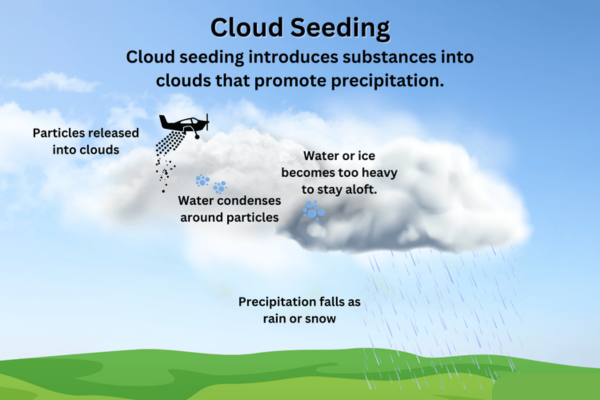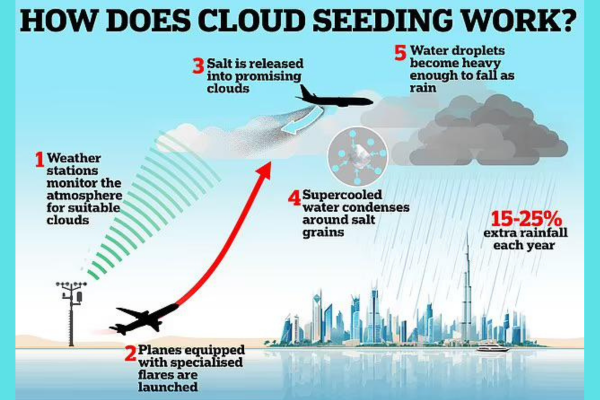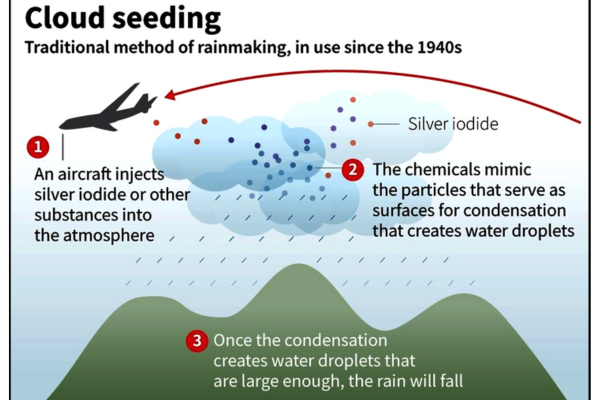As climate change continues to affect weather patterns and water availability worldwide, innovative techniques like cloud seeding are gaining attention. Cloud seeding is a weather modification process that aims to enhance precipitation, manage droughts, and mitigate severe weather conditions. This detailed blog will explore the science behind cloud seeding, its methods, applications, benefits, and potential environmental impacts.
Table of Contents
What is Cloud Seeding?

Cloud seeding is a method of artificially inducing or enhancing precipitation from clouds. It involves dispersing substances into the atmosphere that serve as cloud condensation or ice nuclei, stimulating the formation of rain or snow. The most commonly used substances for cloud seeding include silver iodide, potassium iodide, and sodium chloride (table salt).
How Does Cloud Seeding Work?

The process of cloud seeding generally follows these steps:
Cloud Identification: Meteorologists identify suitable clouds that have the potential to produce precipitation but are not doing so efficiently. Typically, these are cumulus clouds with significant moisture content.
Seeding Agent Dispersion: Seeding agents are dispersed into the clouds using aircraft, ground-based generators, or rockets. These agents act as nuclei around which moisture can condense.
Formation of Ice Crystals or Water Droplets: In cold clouds, substances like silver iodide provide a surface for supercooled water droplets to freeze, forming ice crystals. In warmer clouds, salt particles attract water droplets, causing them to coalesce into larger droplets.
Precipitation: As the ice crystals or water droplets grow larger and heavier, they fall to the ground as precipitation in the form of rain or snow.
Methods of Cloud Seeding

There are three primary methods of cloud seeding:
Static Cloud Seeding: This method involves releasing substances like silver iodide into clouds to provide a nucleus for ice formation. It is typically used in cold clouds to enhance snowfall.
Dynamic Cloud Seeding: Dynamic seeding aims to enhance vertical air currents within clouds, increasing the amount of water available for precipitation. This method requires more precise meteorological analysis and is generally more complex.
Hygroscopic Cloud Seeding: Hygroscopic seeding involves dispersing salts into warm clouds. The salts attract water vapor, leading to the formation of larger water droplets that fall as rain.
Applications of Cloud Seeding

Cloud seeding has various applications, including:
Drought Mitigation: In regions experiencing prolonged droughts, cloud seeding can increase rainfall, replenishing water supplies for agriculture and human consumption.
Agricultural Enhancement: By increasing precipitation, cloud seeding can improve crop yields and reduce the need for irrigation.
Snowpack Augmentation: In mountainous regions, cloud seeding can increase snowfall, enhancing snowpacks that are crucial for water supply during warmer months.
Hail Suppression: Cloud seeding can reduce the size of hailstones, minimizing damage to crops, property, and livestock.
Fog Dispersal: In areas like airports, cloud seeding can be used to disperse fog, improving visibility and safety.
Benefits of Cloud Seeding
Increased Water Supply: Cloud seeding can enhance rainfall in arid and semi-arid regions, improving water availability for drinking, agriculture, and industry.
Economic Gains: Enhanced precipitation can boost agricultural productivity, support hydroelectric power generation, and reduce the economic impacts of droughts.
Disaster Mitigation: By suppressing hail and dispersing fog, cloud seeding can prevent property damage and enhance transportation safety.
Environmental and Ethical Considerations

While cloud seeding offers numerous benefits, it also raises several environmental and ethical concerns:
Chemical Impact: The use of chemicals like silver iodide, although generally considered safe in low concentrations, could potentially impact ecosystems and water quality if used excessively.
Weather Manipulation Ethics: The intentional alteration of weather patterns raises ethical questions about the right to modify natural processes and the potential consequences for neighboring regions.
Effectiveness and Uncertainty: The effectiveness of cloud seeding can vary based on numerous factors, including cloud type, atmospheric conditions, and the accuracy of meteorological predictions. There is ongoing debate about its long-term efficacy and reliability.
Equity Issues: Cloud seeding in one region could potentially deprive neighboring areas of rainfall, raising concerns about the equitable distribution of water resources.
Conclusion
Cloud seeding represents a promising technology for enhancing precipitation and managing water resources in the face of climate change and growing global water demand. While it offers significant benefits, it also requires careful consideration of environmental impacts, ethical implications, and the need for ongoing research to optimize its effectiveness. As we continue to explore and refine cloud seeding techniques, it is crucial to balance the immediate benefits with the long-term sustainability and health of our planet’s ecosystems.






